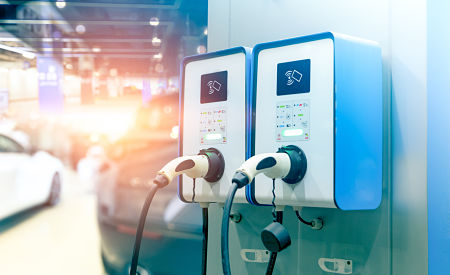White House unveils plan for electric vehicle charging stations
With significant numbers of both car and truck manufacturers now producing electric vehicles, the White House announced a national plan for increased access to electric vehicle charging stations.
Adoption of electric vehicle technology for the big rigs faces some major hurdles, foremost being batteries that will allow the trucks to move long distances without recharging.
Big truck makers MAN and Scania are pouring almost $2 billion into electric truck R&D. Volvo is actively putting its VNR Electric Class 8 trucks on the roads of Southern California at what it calls “an impressive pace right now.” Tesla may or may not start cranking out a few trucks at its own factory once it figures out where to get enough batteries for them. And Daimler subsidiary Freightliner has a demo fleet of electric trucks 40 strong and will introduce commercially available models in numerous classes next year.
A national recharging network could be a game-changer.
President Biden’s goal is for electric vehicles to account for half of new vehicle sales by 2030.
The plan will help establish a “more uniform approach” to charging infrastructure to spur investment in the space and drive customer interest in purchasing such a vehicle, the White House said in a fact sheet.
“The future of transportation in our nation and around the world is electric,” said Vice President Kamala Harris at an event in Maryland. “The auto industry is clearly moving toward electric. We need to make the shift faster and make sure it is driven by the United States.”
The Department of Energy and Department of Transportation will create a joint Office of Energy and Transportation devoted to deploying electric vehicle infrastructure. That office will initially focus on constructing public charging stations to ensure people living in neighborhoods without charging infrastructure have access, Harris said.
The two departments also intend to create an advisory committee focused on electric vehicles, appointing members by the end of March. Additionally, they are working with manufacturers to move electric vehicle production to the US.
The White House is organizing several stakeholder meetings to discuss partnering with state and local governments as well as interest groups.
The recently passed bipartisan infrastructure law included $5 billion for states to help build a national charging network to achieve Biden’s target of deploying 500,000 chargers across the nation, according to the White House. The Biden administration has touted the law as the nation’s largest-ever investment in electric vehicle charging infrastructure.
That legislation included $2.5 billion in grants for communities to fund “innovative approaches” while meeting the president’s priorities, such as projects that support electric vehicle charging access in disadvantaged areas or improve local air quality, according to the White House.
DOT is working on guidance and standards for communities to deploy charging stations supported by the infrastructure legislation. The department is aiming to unveil that guidance by Feb. 11, followed by charger safety and operating standards by March 13.
The Biden administration is also targeting domestic manufacturing of electric vehicle batteries and components, including sourcing critical minerals for such technologies in the US. The infrastructure package included more than $7 billion in funding across the battery supply chain.
“The pandemic delayed introduction of electric trucks, creating delays in development and testing,” Don Ake, vice president of commercial vehicles for Freight Transportation Research told Autoweek. “There is increased competition between the large OEMs and several new players, so there is a race to get the products to market quickly.”
Ake said government subsidies will probably be required to get the new technology on the road in significant numbers.
“There are several barriers to adoption,” said Ake. “The trucks have new engines so they still have to prove they can hold up to standard over-the-road rough conditions. There needs to be the charging infrastructure set up to handle the expected volume. The trucks must make sense from a cost standpoint. These are commercial vehicles. Fleet usage depends on costs, not environmental issues. The government will need to provide subsidies for the use of electric trucks for a period, until advanced technology lowers the cost of operation.”






